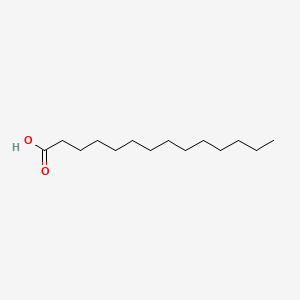| MeSH term | MeSH ID | Detail |
|---|---|---|
| Myalgia | D063806 | 1 associated lipids |
| Noonan Syndrome | D009634 | 1 associated lipids |
| Neoplasms, Vascular Tissue | D009383 | 1 associated lipids |
| Hepatitis D | D003699 | 1 associated lipids |
| Vaccinia | D014615 | 1 associated lipids |
| Diabetic Cardiomyopathies | D058065 | 1 associated lipids |
| Caliciviridae Infections | D017250 | 2 associated lipids |
| Shwartzman Phenomenon | D012790 | 3 associated lipids |
| Yellow Fever | D015004 | 3 associated lipids |
| Gallbladder Neoplasms | D005706 | 3 associated lipids |
Tetradecanoic acid
Tetradecanoic acid is a lipid of Fatty Acyls (FA) class. Tetradecanoic acid is associated with abnormalities such as Chronic lung disease, Infection, Spastic syndrome, Diabetes and Cardiovascular Diseases. The involved functions are known as Fatty acid biosynthetic process, Anabolism, lung alveolus development, 5-(carboxyamino)imidazole ribonucleotide mutase activity and Homeostasis. Tetradecanoic acid often locates in Structure of parenchyma of lung, Blood, Head, Membrane and Cytoplasmic matrix. The associated genes with Tetradecanoic acid are SLC33A1 gene, SFTPA1 gene, P4HTM gene, Polypeptides and GPR132 gene. The related lipids are Fatty Acids, Nonesterified Fatty Acids, palmitoleic acid, Phosphatidylglycerols and Butanols.
Cross Reference
Introduction
To understand associated biological information of Tetradecanoic acid, we collected biological information of abnormalities, associated pathways, cellular/molecular locations, biological functions, related genes/proteins, lipids and common seen animal/experimental models with organized paragraphs from literatures.
What diseases are associated with Tetradecanoic acid?
Tetradecanoic acid is suspected in Infection, Cardiovascular Diseases, Obesity, Chronic lung disease, Diabetes, Diabetes Mellitus, Non-Insulin-Dependent and other diseases in descending order of the highest number of associated sentences.
Related references are mostly published in these journals:
| Disease | Cross reference | Weighted score | Related literature |
|---|
Possible diseases from mapped MeSH terms on references
We collected disease MeSH terms mapped to the references associated with Tetradecanoic acid
PubChem Associated disorders and diseases
What pathways are associated with Tetradecanoic acid
There are no associated biomedical information in the current reference collection.
PubChem Biomolecular Interactions and Pathways
Link to PubChem Biomolecular Interactions and PathwaysWhat cellular locations are associated with Tetradecanoic acid?
Visualization in cellular structure
Associated locations are in red color. Not associated locations are in black.
Related references are published most in these journals:
| Location | Cross reference | Weighted score | Related literatures |
|---|
What functions are associated with Tetradecanoic acid?
Related references are published most in these journals:
| Function | Cross reference | Weighted score | Related literatures |
|---|
What lipids are associated with Tetradecanoic acid?
Related references are published most in these journals:
| Lipid concept | Cross reference | Weighted score | Related literatures |
|---|
What genes are associated with Tetradecanoic acid?
Related references are published most in these journals:
| Gene | Cross reference | Weighted score | Related literatures |
|---|
What common seen animal models are associated with Tetradecanoic acid?
There are no associated biomedical information in the current reference collection.
NCBI Entrez Crosslinks
All references with Tetradecanoic acid
Download all related citations| Authors | Title | Published | Journal | PubMed Link |
|---|---|---|---|---|
| Akita H et al. | A neutral lipid envelope-type nanoparticle composed of a pH-activated and vitamin E-scaffold lipid-like material as a platform for a gene carrier targeting renal cell carcinoma. | 2015 | J Control Release | pmid:25543000 |
| Murata M et al. | Expression and characterization of myristoylated preS1-conjugated nanocages for targeted cell delivery. | 2015 | Protein Expr. Purif. | pmid:25497224 |
| Petrov AM et al. | Inhibition of protein kinase C affects on mode of synaptic vesicle exocytosis due to cholesterol depletion. | 2015 | Biochem. Biophys. Res. Commun. | pmid:25446113 |
| Charlton TM et al. | Quantitative Lipoproteomics in Clostridium difficile Reveals a Role for Lipoproteins in Sporulation. | 2015 | Chem. Biol. | pmid:26584780 |
| MartÃnez L et al. | Myristic acid potentiates palmitic acid-induced lipotoxicity and steatohepatitis associated with lipodystrophy by sustaning de novo ceramide synthesis. | 2015 | Oncotarget | pmid:26539645 |
| Rampoldi F et al. | Immunosuppression and Aberrant T Cell Development in the Absence of N-Myristoylation. | 2015 | J. Immunol. | pmid:26423150 |
| Takamitsu E et al. | Identification of Human N-Myristoylated Proteins from Human Complementary DNA Resources by Cell-Free and Cellular Metabolic Labeling Analyses. | 2015 | PLoS ONE | pmid:26308446 |
| Zhang P et al. | An Isoform-Specific Myristylation Switch Targets Type II PKA Holoenzymes to Membranes. | 2015 | Structure | pmid:26278174 |
| Serwa RA et al. | Systems Analysis of Protein Fatty Acylation in Herpes Simplex Virus-Infected Cells Using Chemical Proteomics. | 2015 | Chem. Biol. | pmid:26256475 |
| Scheidt HA et al. | Structural Thermodynamics of myr-Src(2-19) Binding to Phospholipid Membranes. | 2015 | Biophys. J. | pmid:26244740 |
